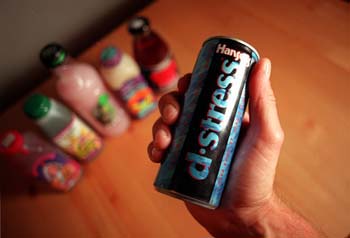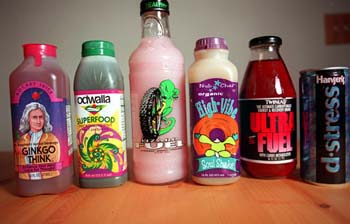![[Metroactive Dining]](/dining/gifs/dining468.gif)
[ Dining Index | San Jose | Metroactive Central | Archives ]
 Photograph by George Sakkestand Modern Snake Oil: Shelves in health food stores and supermarkets alike are chock full of beverages doctored with echinacea, gingko biloba, kava kava and other elixirs du jour. Millennial Elixirs A glance at the designer soda-pop market produces Y2K jitters By Christina Waters IN THE BEGINNING there was Coca-Cola, loaded with caffeine, guarana derivatives and a soupçon of cocaine. So popular was this energizing liquid refreshment that the very label became synonymous with all that was great about America. Some have even claimed that World War II was fought so that Europeans and Asians could have the right to drink as much Coke as they wanted. But this is now, not then. And while soft-drink advertisements still proclaim that Americans should find their identity in a can of effervescent liquid, some consumers are looking for more from their refreshments. That's especially true of the post-hippie generation. On a quest for love, peace and a lucrative IPO, they have precious little time to get natural. So they turn to entrepreneurial schemes to access vitamins, minerals and legal highs. For those who can't spend hours grazing at alternative food stores for elixirs du jour, there are New Age alchemists with potions full of all the echinacea, kava kava and caffeine the body could handle. And then some.
Tasting Notes: A random sample from a glutted field.
The quest for the ultimate health drink began in the '80s (just after recreational drugs nose-dived into the collective unconscious) and continued unabated into the '90s. And as we sit poised on the cusp of the second millennium, we're faced with a soft-drink glut of epic proportions. What we've got here is a failure to eliminate. A shakedown is coming--hide and watch. Even a casual perusal of supermarket shelves in Anytown, USA, provides shocking evidence of the 15 minutes currently enjoyed by fortified soft drinks. Drinks with warm and fuzzy names like Amazon Mist and Fruitopia. Drinks with testosterone-driven names like Brain Wave, Cult Energy, Aqua Java and Jolt. Tyler Durden drinks this stuff. An equally casual glance at every other bottle/can/jar on those shelves tells us that most of these products are the No-Doz of the fin de siècle, liquid speed to help the hormonally challenged stay at their websites through the night. The conceptual confusion of these latter-day concoctions is summed up by "Water Joe." Marketing on the web notes without a trace of irony that this product is caffeine-enhanced natural artesian water. Insomnia in a can. "Sleep is now optional," promises the corporate slogan.
The other big category is the herbally enhanced, vitamin-packed concoction, like the huge swell of flavored green teas (Hansen's, Snapple, Tazo, et al.), and orange- and grape-juice-based drinks laced with nutri-supplements. They're dosed with echinacea, ginseng, St. John's wort and gingko biloba--though no one knows just how much. Does a drink like Red Bull Energy Drink (ripped to the max with caffeine) actually work? Well, yes. One brightly colored can will ward off sleep as effectively as a cappuccino. But does Hansen's Anti-Ox actually retard aging, boost the immune system or protect against cancer (as antioxidants are said to do)? Well, by the time test results are in, this product will have disappeared from cultural memory. A typical product description, taken at random from herbal packaging, is revealing. "Ginkgo biloba can be important for the function of the brain; it may improve memory, mental function and clarity. It also may assist the system for some in delayed aging." There are no FDA regulations on nutriceutical claims; hence the words "can" and "may" are carefully included. But anyone who's done some homework on herb and vitamin supplements is aware that there is plenty of anecdotal evidence to support some of these claims. So much has been written on echinacea, ginseng, ginkgo and Vitamin C that they're as good as mainstream. But what do we know about the synthesized amino acid taurine? And does the average 15-year-old boy care? No--that teenager is more interested in Goth packaging and a label that promises "Sexual Energy." The designer beverage racket appears to be divided into products for men--the electrolyte-intensive sports drinks like Ultra Fuel whose way was paved by Gatorade--and for women, who like a non-sweet, low-calorie espresso substitute, like Tazo Tea's Basic Black and Simply Red or various Snapples. Then there are the soda pop substitutes like Berry Bomb and Hansen's Natural Sodas, and the ecologically correct drinks like Odwalla, Sobe and Rocket Juice. And the in-your-face, allegedly mind-altering stuff for the youth market: XTZ, Jolt, Dynamite, Krank2O and Zapped. Better living through chemistry? Make mine Pellegrino! [ San Jose | Metroactive Central | Archives ]
|
From the November 11-17, 1999 issue of Metro, Silicon Valley's Weekly Newspaper.
Copyright © 1999 Metro Publishing Inc. Metroactive is affiliated with the Boulevards Network.
For more information about the San Jose/Silicon Valley area, visit sanjose.com.
![[line]](/gifs/line.gif)
